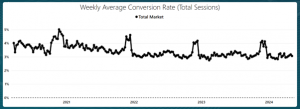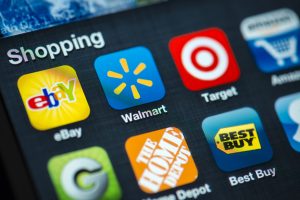By Ellie-Rose Davies, Content Executive at IMRG
IMRG data has shown that ecommerce conversion rates have been down in the last couple of years. To help retailers experience some growth in this metric, this blog reviews all the stand-out strategies to boost conversion in 2024.
We have looked at examples of retailers who have implemented innovative tactics to grow and have considered the impact varying approaches has on brands. Read on to learn more about the trends our community are seeing.
What has happened to conversion?

The weekly average conversion rate (total sessions) for the total market has been on a steady decline since 2021, according to IMRG’s Online Retail Index. This owes to multiple factors, including the easing of pandemic restrictions which saw customers return to the high street, economic uncertainty with the rising cost of living reducing customers’ propensity to purchase, and increased marketing costs amid heightened online competition.
Meanwhile, the average basket value (ABV) for the total market been increasing. Take the month of April, where in 2021 the ABV was £122.35, and now in 2024 the value stands at £148.51. Though, while the average basket value has been increasing, Year-on-Year monthly revenue has been down.
We can infer that inflationary pressures have increased prices, and customers are making more considered and less frequent purchases.
What innovative conversion rate tactics are retailers using?
1. Experimentation with personalisation
One of the focus areas is on personalisation. We are seeing more retailers try to be relevant to every prospective customer that interacts with their website and other platforms.
Dan Bond, VP of Marketing at RevLifter shares that ‘Understanding customer intent is the key to improving conversion rates. It is crucial to know what has brought someone to your site and what they are hoping to achieve by visiting. Are they looking to make a purchase immediately, or are they in the research phase? Did they come directly to you because they know your brand, or did they find you via search?’
He urges retailers to ‘analyse their data and uncover behavioural insights. Then, they can focus on the push and pull factors that can increase conversions. If someone is researching, you should focus on showing them more products and highlighting the benefits of purchasing. A special offer or discount will get them over the line if they are ready to buy.’
‘Test different tactics and offers to find the answers,’ says Dan. ‘There’s no shortcut; hard work over time leads to performance improvements.’
Also considering the value of personalised offers is Bill Schneider, VP of Product Marketing at SheerID, who champions targeted messaging to intended audiences and offers that a customer ‘can’t refuse.’ Bill reflects on how ‘Hundreds of brands positively impact conversions by creating exclusive offers for communities like college students or healthcare workers. Back Market, a high-quality refurbished equipment retailer, has a student discount to acquire new GenZ customers.’
Using digital verification, Black Market ‘authenticated eligible college students to redeem the offer and saw a 5x increase in back-to-school orders. Because the offer was unique, students had a 30% higher CLV than their typical cohort.’
Burc Tanir, CEO at Prisync says, ‘In 2024, retailers can innovate by embracing new payment methods, integrating social commerce, and using data analytics for real-time decision-making.’
‘For those anxious about innovation, start with small experiments, gather feedback, and iterate. Chatbots, creative pop-ups and personalised banners benefit customer service-heavy retailers, while dynamic pricing algorithms suit flexible pricing strategies. Flexibility, customer-centricity, and a willingness to experiment are vital in thriving retail environments.’
2. Improving and refining retail apps
Retailers are trying to boost conversion through pushing customers towards using their apps. The incentive is typically that the app has extra benefits, such as exclusive offers or unique features. The intention is to create an app experience that will make customers want to return, instead of them deleting the app once any incentive has been redeemed.

VP of sales and marketing at Huboo, Andrew Harkness, reveals that ‘Right now we’re seeing a big push towards deeply personalised shopping experiences that leverage advanced tech like AR and highly tailored apps. A great example of this is Nike’s app which tracks each user’s activity and makes personalised product recommendations based on their preferences – a strategy that has led to a significant increase in in-app purchases.’
Andrew exclaims, ‘We’ve also seen similar tactics work for AU Vodka which, through its highly-rated app, offers customers exclusive discounts and promotions that aren’t available anywhere else – helping push instant online sales.’
‘In addition, AR is proving crucial for an integrated customer journey, blurring the lines between digital and physical storefronts.’ Andrew says, ‘The IKEA Place app has really excelled at this – using AR to let users see how products would look in their homes and experiment with different colours and styles. This drastically aids the online buying experience and enables consumers to make purchasing decisions at a much faster rate.’
“Super apps” have been a growing trend, as noted by Monica Eaton, Founder, Chargebacks 911. She says, ‘One method of providing consumers with such accessibility, ease of shopping and a better customer experience is by leveraging the growing trend of ‘super apps.’
‘Super apps are platforms that have evolved from straightforward, single-use applications into all-in-one service brimming with a variety of features. These apps blend functionalities like messaging, social media, payment processing, and shopping into one handy application. Super apps like WeChat, Alipay, and Meituan have already taken Asia by storm, and Elon Musk and Mark Zuckerberg have expressed intent on creating an ‘everything app’ for X (formerly Twitter) and Meta, respectively.’
Monica shares that ‘Super apps can enable a consistent experience across brands, meaning the shopping experience for the customer feels familiar, no matter the merchant. As super apps become more popular, merchants can assess their place within this burgeoning medium that, if used correctly, could drastically improve a retailer’s bottom line.’
3. Optimising website design and layout
Modo25’s Head of CRO, Luke McDermott argues that ‘By leveraging innovative design and strategically placing CTAs, retailers can capitalise on increased user experience which directly translates to increased conversions.’
‘One transformative strategy has been the implementation of an accordion-style layout, which streamlines information and strategically places the ‘checkout’ CTA button above the fold. This approach ensures that crucial steps in the purchasing process are clearly displayed and easily accessible to customers.’
Reducing friction at every stage of the customer journey and ensuring that every interaction is easy, engaging, and informative can significantly help conversion rates. Customers are less likely to stay on a page if they must scroll to find what they need.
IMRG research has shown that most retailers place their delivery and returns information below the fold. Knowing that delivery concerns can significantly reduce a customer’s willingness to buy from a retailer, this information can be placed across multiple touchpoints, above the fold. For example, at the top of the home page, product pages, and the checkout.
4. Accelerating growth through fulfilment
Once a customer has decided to make a purchase with a retailer and is at the checkout, it is important that each step following is seamless.
Gavin Murphy, CMO at Scurri comments, ‘Having the right delivery strategy in place for your ecommerce website can result in a higher conversion rate. Online shoppers want to feel in control of their delivery experience and ensuring they know they can receive their products without disruption to their routine is key.’
‘Additionally, given the current squeeze on conversion rates due to cost-of-living pressures, and with consumers taking longer to validate their purchasing decisions, retailers need to consider how and when they can re-engage the shopper, setting them up to consider their next purchase. Post-purchase customer engagement, which takes place after the consumer has checked out, is a key platform for this – and is often when the shopper is most likely to interact with brand-led communications, providing a valuable and effective channel to up- or cross-sell to the consumer.’
Industry experts, Fulfilment Crowd reveals the importance of personalised experiences, stating that ‘Our research reveals a third of brands intend to boost investment in tailored promotions over the next year.’
‘Personalisation guides buyer journeys, fostering direct brand connections and facilitating targeted cross-selling. Expanding personalisation across the entire customer journey is vital, with post-checkout personalisation offering untapped potential for increased ROI through repeat business. Strategies include unique packaging elements that encourage shareable unboxing experiences and differentiated added extras and collateral. We are seeing retailers increasingly align packaging designs with social media campaigns.’
Another area that is rapidly evolving is the online marketplace, where Tradebyte’s Head of UK Sales, Freya Dickens shares projections which indicate that ‘up to 50% of businesses will be direct-to-consumer (DTC) by 2025.’
‘Platforms like Zalando are capitalising on this growth by offering brands diverse fulfilment options such as the launch of its new ZEOS service enabling multi-channel logistics solutions across Europe within one unified platform. This will transform EU marketplace expansions by enabling brands to maintain a single stock pool in Europe while serving multiple platforms like About You, Otto, La Redoute, ASOS, Amazon and Bol.’
Freya says, ‘With brands able to streamline their logistics and integrate seamlessly with multiple marketplaces, customers gain access to a broader product range offering, fostering engagement and driving higher conversions.’
5. Seeking help with partners
If you would like help with optimising your conversion rates, IMRG have a wide community of Technology Partners, like the ones featured in this blog, who can help.
As stated by Martyna Zygaj, Technology Partner Consultant at Awin, ‘One of the quick wins retailers can implement to experience growth is integrating with Technology Partners. Technology Partners are powerful add-ons that optimise conversion rates, increase average order values, and help acquire new customers.’
‘Technology Partners can help retailers optimise traffic they already generate, ensuring it converts effectively through solutions such as exit intent, product recommendations, referral marketing, bounce recovery and more. Such solutions can drive up to 30% increase in conversion rate, making them an attractive alternative for retailers looking to maximise their revenue.’
Want to read more? Here are some other IMRG blogs that cover a range of ecommerce topics:
Ecommerce Merchandising: Optimising Product Displays, Recommendations, & Navigation – IMRG
The Real Reasons Gen Z Are More Likely To Return Gifts Than Their Grandparents – IMRG
How Is The Luxury Market Accelerating Growth For 2024? – IMRG
Top Ways To Improve The Post-Purchase Customer Experience – IMRG
8 Red Flags Your Checkout Is Not Optimised For International Customers – IMRG
Published 20/05/2024


